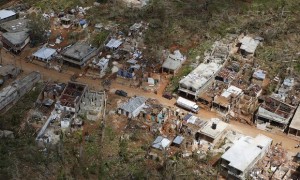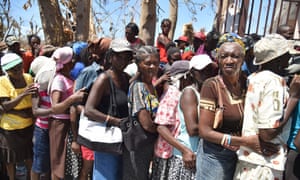In the wake of Hurricane Matthew, officials and experts discuss and examine what the short and long term impacts will be. IJDH’s Beatrice Lindstrom discusses the major role cholera will play as time progresses and many are left without adequate treatment.
Haiti faces fresh cholera outbreak after Hurricane Matthew, aid agencies fear
Amanda Holpuch, The Guardian
October 14, 2016

Cholera is surging in Haiti after Hurricane Matthew fouled wells, flooded rivers and latrines and forced survivors to drink contaminated storm water – even in regions that have received some deliveries of emergency aid.
Less than two weeks after the earthquake, at least 200 suspected new cases of cholera have been detected in the country, according to the World Health Organization (WHO), which is sending 1m cholera vaccines to Haiti at the end of this week.
Aid agencies fear that without a major effort by the international community, survivors of the storm will face a fresh outbreak of the disease.
“There will be many more cases of cholera, and unnecessary deaths, all across areas affected by the hurricane if large-scale cholera treatment and prevention response doesn’t reach them immediately,” said Conor Shapiro, president and CEO of the St Boniface Haiti Foundation, which operates a hospital in the southern part of Haiti.
Hurricane Matthew killed at least 473 people, and 752 people are missing, according to the United Nations’ latest tally.

And if access to food, water and shelter does not improve immediately, the death toll is expected to increase. In its wake, the hurricane left pools of stagnant water, overflowing rivers and dead bodies – creating a breeding ground for the waterborne disease.
In the worst-hit regions, efforts to deliver water treatment equipment have been hampered by debris that still blocks roads. And even those places that have received support have reported “huge” shortages of clean drinking water, forcing people to drink stormwater, said Beatrice Lindstrom, staff attorney at the Institute for Justice and Democracy in Haiti (IJDH). “It’s a race against time,” she said.
Lindstrom’s group has led a campaign to hold the UN accountable for its role in the cholera outbreak that hit nine months after the January 2010 earthquake. The disease was previously unknown in Haiti, and overwhelming evidence suggests that it was introduced to the country by UN peacekeepers from Nepal.
More than 9,200 people have since died from cholera and more than 769,000 have been treated in hospitals for the disease – and Lindstrom said that the hurricane has prompted fears of a fresh epidemic.
“In the first month after cholera broke out, after the earthquake, a thousand people were impacted,” said Lindstrom. “We’re really afraid that the same thing will happen in this situation – it just seems like access to water is already so, so limited.”
Those seeking treatment for the disease must confront a depleted healthcare system – a quarter of Haiti’s healthcare facilities, including cholera treatment centers, have been destroyed.
“What Matthew didn’t kill, cholera and infections are going to. Infections are coming in,” said the Haitian Health Foundation country director, Nadesha Mijoba,speaking from Jérémie, a city of 30,000 that was hit by the full force of the category 4 hurricane.

The foundation serves Jérémie and 105 nearby mountain villages and is sending weekly food dispatches to 15 local orphanages, which have no refrigeration or storage. Of the foundation’s 184 staff members, 130 were made homeless by the hurricane.
“The situation was not easy after the earthquake, and with Hurricane Matthew, the situation has become more critical,” said Marie Thérèse Frédérique Jean Pierre, the Haiti director for children’s humanitarian group, Plan International.
In some places, 80% of the roofs have been lost, and 100% of the crops – which are grown primarily to feed the people who harvest them – have been destroyed. “The devastation will have a direct consequence on the population [and] will increase the malnutrition problems, mainly for children,” said Jean Pierre.
“I’m not afraid to say it, but in another three, four months, Haitians are going to die of starvation,” Emmanuel Valcourt, a farmer in the south, told the Miami Herald. “I really don’t see how we’re going to rebuild. We don’t have the financial means. We don’t have a job that would have allowed us to have savings. The few animals that we had are all dead.”
Jean-Luc Poncelet, a WHO representative in Haiti, said crop destruction in Haiti is particularly devastating because the food is grown by people to feed themselves. “That [food] has been washed away either by floods, and landslides and winds,” said Poncelet.

He said that since only 10% of the country’s population was affected by the hurricane, recovery efforts and resources should be channeled through the country’s remaining population and institutions. “Channeling through institutions that exist in the country would be the most efficient,” Poncelet said.
But amid these concerns about food and shelter, the threat of contaminated water reigns.
“It really does seem like this is one of the most urgent situations that’s facing people after the hurricane,” said IJDH’s Lindstrom.
“The reports we’re getting from the ground so far are pretty horrific. There are still a number of towns that are completely cut off from aid because they are so inaccessible by road and even the ones who are slowly getting aid in, there is a huge shortage of potable water,” she said.
Plan International’s Jean Pierre said: “All our action through this emergency response will be to make sure children are safe and their families have some opportunities, some capacities to return to the normal life.”
Click HERE for the original article.